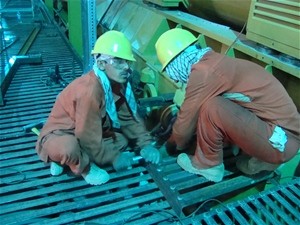
Trainees at the Tarakhil power plant install a fabricated platform that provides access to the turbines and other machinery. The plant generates enough electricity for 1.5 million citizens.
USAID/AIRP
USAID believes that capacity building is an effective tool in all professions.
11 OCTOBER 2010 | KABUL, AFGHANISTAN
Built by USAID’s Afghanistan Infrastructure Rehabilitation Program, the new 105-megawatt Tarakhil Power Plant has trained workers at every skill level, helping to ensure sustainable operations of the plant that provide a reliable source of electricity to the region.
When construction of the plant began on an arid field once used as an artillery range and garbage dump on the outskirts of Kabul, many of the hired laborers did not possess the skill for operations and maintenance of a power facility. Yet many of these workers performed at high levels and were interested in improving their skills.
According to managers, the workers volunteered to forego their pay in return for training that would help them improve their skills, while contributing to the delivery of vital infrastructure for their fellow citizens. “They said we will train you,” a former painter said. “I had no chance before to learn, no opportunity. Now, I can weld.”
A result of their effort is a unique grated platform that provides ventilation and access to the huge diesel turbines. Workers measured and cut hundreds of flat steel rods, drilled holes at regular intervals, and fitted pieces together in a grid. If pieces did not fit, they were redone.
“To my knowledge, there is no other grating in the world designed and built for a plant like this,” said the supervisor, who was also the workers’ instructor.
The managers were not the only ones to be impressed. U.S. Ambassador Karl Eikenberry, speaking at the ceremony to hand over the plant to the Government of the Islamic Republic of Afghanistan, pointed to workers in brightly colored jump suits and hardhats. Many were the newly skilled, higher paid workers who built the walkway to the powerful machines that provide 600,000 Afghans with access to electricity.
“These fine young men in orange are the future of Afghanistan and the reason for hope and confidence,” the Ambassador said.
The success of the plant exemplifies USAID’s faith in the ability of Afghans to rebuild their country and provide services and jobs for the future of the Afghan people.







Comment
Make a general inquiry or suggest an improvement.